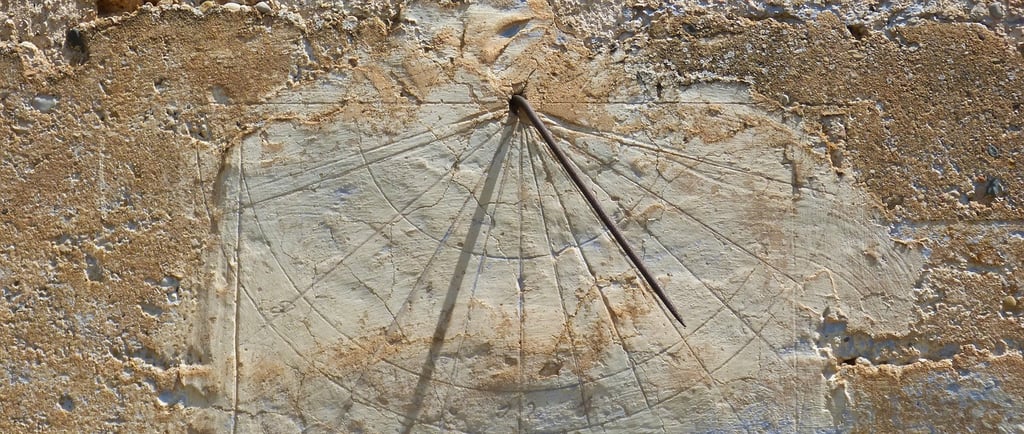The Sundial🌞Ancient Timekeeping⏳
Stories About Time: Measuring Moments Through History ⏳🌞🌕 from the chapter "Towards an Understanding of Linear Time" from the History Album. In this chapter we invite children to a journey through the fascinating evolution of timekeeping. Starting with observing the Sun🌞, and people who first noticed the movement of shadows to mark the day, to the people who noticed the phrases of the Moon 🌙, and tracked the lunar cycle to create months, these stories uncover humanity’s inventive ways of measuring moments.Children will marvel at ancient innovations, like sundials and lunar calendars, and explore cultural contributions, such as candle clocks 🕯️ and water clocks 🌊, that paved the way for modern timekeeping. Each story weaves history, science, and culture, showing how humans connected with the natural world to organize their lives. 🌿✨Through these narratives, children will see time not just as a number on a clock, or passing month on the callendar, but as a rich legacy of human curiosity and creativity. With hands-on activities like building sundials and journaling moon phases, they’ll become modern-day timekeepers, inspired to ask, “How did people measure time before clocks?” and “What can I discover about time?”This vivid exploration links the past to the present, sparking imagination and a deeper appreciation for the ingenuity of those who came before us. 🌍✨
HISTORY STORIES
12/10/20243 min read


Remember playing outside on a sunny day and watching your shadow? Maybe it stretched long behind you in the morning, or it was short and almost disappeared at noon. Shadows are fun to observe, but long ago, people used used them for something very important—they helped people tell time!
A long, long time ago, in 3500 BCE there were no clocks or watches. People didn’t have phones to tell them the hour. Instead, they looked up at the sun 🌞. They noticed something amazing: the sun always rose in the east 🌅 (meaning "dawn") and set in the west 🌇 (meaning "evening" or "setting"). They started watching the sun very carefully, following its journey across the sky.
People noticed something curious. 🌳 The sun was shining, and the tree cast a long shadow on the ground. As the day went on, the shadow grew shorter and shorter, until it was barely there at noon 🕛. Then, in the evening, the shadow stretched out again, this time in the opposite direction! “Hmm, these shadows change as the sun moves. Maybe we can use them to measure the passing time!”
So people did some experiments. They took a stick and planted it firmly in the ground, just like this! (Demonstrate by planting a straight stick.) This wasn’t just any stick—it had a special job! It showed where the shadow fell at different times of the day. And because people like naming things, they gave this important stick a name too: 👏 Gno – mon 👏! The word comes from Greek and means "indicator" or "something that knows." The gnomon “knew” the time by following the sun’s movements.
The gnomon became an important tool for the sun watchers. Every morning, its shadow stretched long and pointed west 🌅. By noon 🕛, it was short and straight beneath the stick. In the evening, the shadow grew long again, but this time it pointed east 🌄. People marked the ground where the shadow fell at different times. Soon, they had created a tool to tell time just by watching the shadows! 🕶️ ( demonstrate the markings by using a marker and a light source representing the movement of the sun so children can see how the gnomon shadow moves.)
The marks that people made became the dial of this special clock called a Sundial, with 'dial' meaning "a tool that measures." 🕰️ This tool was so helpful that it spread to many cultures around the world! In ancient Egypt, tall obelisks acted as gnomons to tell time. In Greece, people designed intricate sundials to measure the hours of the day. And in China, sundials were used to organize daily life and plan important events. These cultures made sundials not just useful, but beautiful too!
But there was one big problem… 🌧️ What happened when the clouds covered the sky? Or when night fell? The gnomon couldn’t make a shadow then! People wondered, “How will we tell time when the sun isn’t here to guide us? 🌑”
Though the sundial was an amazing tool, it could only work on bright, sunny days ☀️. But what about other ways to measure time? Could there be tools to help on cloudy days or at night? 🌙 And you know, when people face problems, they look for solutions. And soon, another way to measure the passing time was invented. But this is a story for another day… 🕯️✨
I wonder... How did people figure out that shadows could tell time? Do you think they experimented, or was it an accidental discovery?”
If children research further on how to make a sundial, they will eventually discover that the gnomon needs to be tilted toward true north at a specific angle depending on the latitude to be accurate all year round.
Follow-Up Activities:
Build Your Own Sundial: Use a pencil or stick and mark the shadows throughout the day. Watch how they grow long and short! 🪵✨
Sunrise & Sunset Journal: Observe when the sun rises and sets for a week. Does it change each day? 🌅🌇
This story is part of the following Clock Stories Series which can be turned into Drama Play or Storybook Compilation.
Ancient Timekeeping
🌞 The Sundial ~3500 BCE
🌊 The Water Clock ~1500 BCE
🏛️ The Tower of the Winds ~50 BCE
Medieval Timekeeping
🕯️ The Candle Clock ~980 CE
🌌 Su Sung’s Astronomical Water Clock ~1092 CE
⏳ The Hourglass Sand Masters ~14th Century
🛎️ The Mechanical Church Bells ~14th Century
Science in Timekeeping
🌟 Astronomical Marvel: The Prague Clock ~1410 CE
🌍 Galileo’s Pendulum Discovery ~1602 CE
🕰️ Pendulum Perfection ~1656 CE
Modern Timekeeping
🌊 John Harrison’s Marine Chronometer ~18th Century
⏱️ The Quartz Revolution ~1920s CE
With Montessori joy,
Vanina 😊

